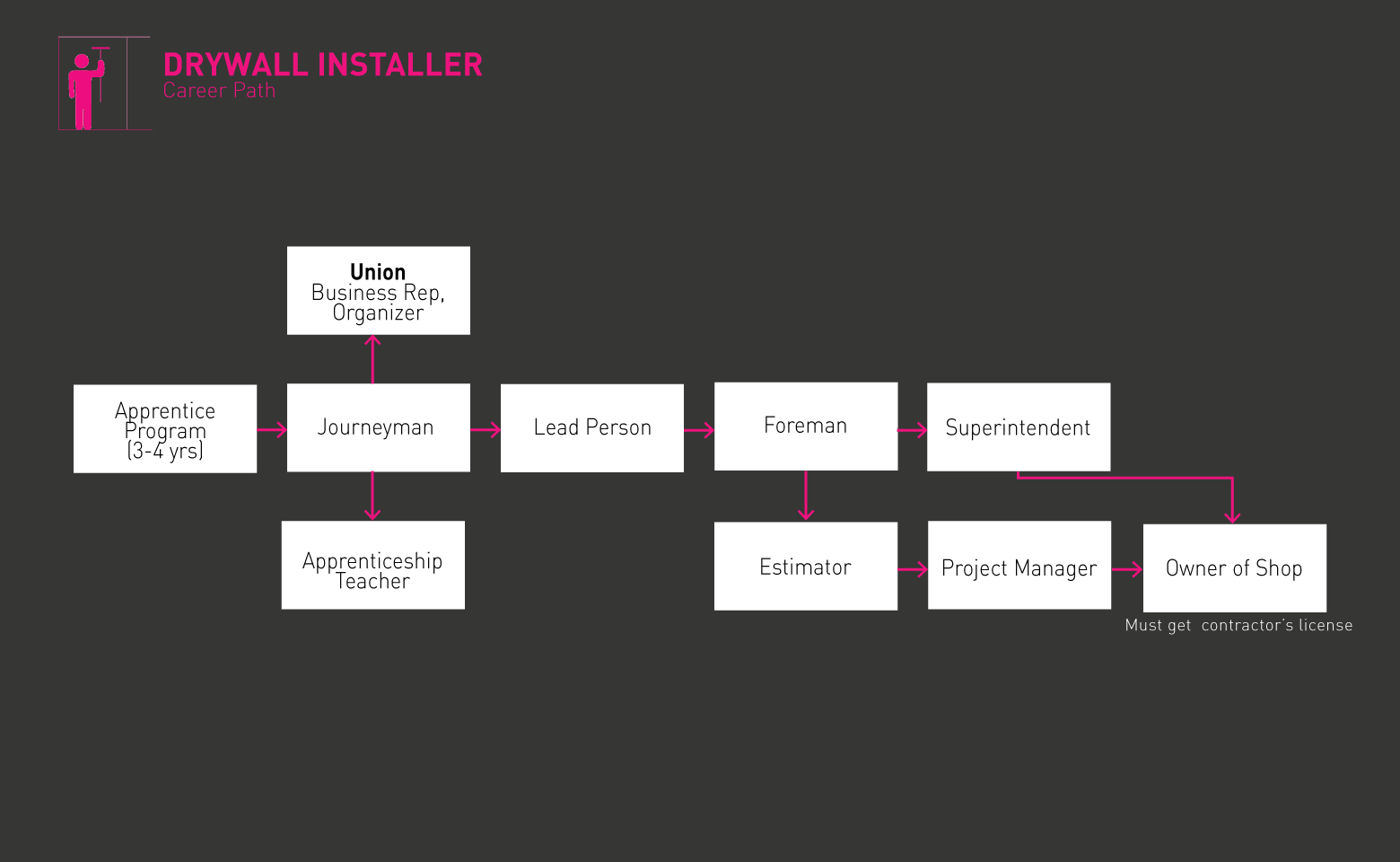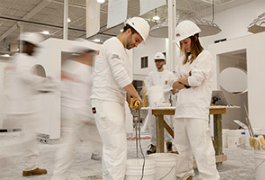Focos
Acabador de paneles de yeso, instalador de paneles de yeso, mecánico de paneles de yeso, instalador de techos, instalador de paredes de yeso, especialista en interiores y exteriores, instalador acústico, montador de estructuras metálicas, montador de estructuras metálicas con montantes.
Los instaladores de paneles de yeso y baldosas para techos colocan paneles en las paredes y techos del interior de los edificios. Los acabadores preparan los paneles para pintarlos, utilizando cinta adhesiva y otros materiales.
- La sensación de satisfacción al terminar un proyecto.
- Autonomía: Puedes trabajar tanto o tan poco como quieras. Basado en proyectos.
- Normalmente se empieza a las 6:30 a. m. y se termina a las 3:30 p. m.: posibilidad de realizar otros proyectos por la tarde.
- ¡Trabaja con tus manos!:«Si te gustan los trabajos manuales, los oficios son una opción excelente».
«Llevé a mis hijos a la Academia de Ciencias de California. Dirigí ese proyecto cuando se construyó por primera vez. Les encanta ir allí y poder decirle a la gente que «mi papá pintó esto». Ver el orgullo y la alegría en sus ojos... que casi formaban parte de ello. Se trata de sentir orgullo por el trabajo artesanal». RobertWilliams III, pintor, representante comercial, Consejo de Distrito 16.
Los instaladores de paneles de yesosuelen realizar las siguientes tareas:
- Revisa los planos de diseño para minimizar el número de cortes y el desperdicio de paneles de yeso.
- Mide la ubicación de los enchufes eléctricos, las tuberías, las ventanas y los conductos de ventilación.
- Corta paneles de yeso al tamaño adecuado, utilizando cuchillas multiuso y sierras eléctricas.
- Fija paneles de yeso a los montantes de las paredes interiores con clavos o tornillos.
- Recorte y lije los bordes irregulares para que las tablas encajen de manera uniforme.
Los instaladores de placas de techosuelen realizar las siguientes tareas:
- Medidas según planos o dibujos.
- Soportes con clavos o tornillos.
- Coloca baldosas o láminas de materiales amortiguadores en los techos.
- Mantiene las baldosas en su sitio con adhesivo de cemento, clavos o tornillos.
- A veces se les llama carpinteros acústicos porque trabajan con baldosas que bloquean el sonido.
Los taperssuelen hacer lo siguiente:
- Prepara la superficie de la pared (paneles de yeso) tapando los agujeros de los clavos.
- Aplica cinta adhesiva y utiliza compuesto sellador para cubrir las juntas entre los paneles de yeso.
- Aplica capas adicionales de compuesto sellador para crear una superficie uniforme.
- Lija todas las juntas y agujeros hasta obtener un acabado liso y sin imperfecciones.
Los instaladorestambién sedenominan enmarcadores o colgadores.Los tapadorestambiénsedenominan acabadores.
- Destreza manual: hábil con las manos.
- Coordinación mano-ojo
- Pensamiento crítico y resolución de problemas: Te encontrarás con problemas inesperados y tendrás que resolverlos rápidamente.
- Atención al detalle
- Fuerza física y resistencia
- Funciona en interiores.
- Bastante exigente físicamente: los trabajadores pasan la mayor parte del día de pie, agachándose o estirándose, y a menudo deben levantar y manipular paneles de yeso pesados y de gran tamaño.
- Para trabajar en techos, es posible que tenga que subirse a zancos, escaleras o andamios.
- Es obligatorio usar máscaras protectoras, gafas y guantes.
- Empresa contratista de paneles de yeso: desde pequeños negocios familiares (4-8) hasta grandes empresas (más de 200).
- Mantenimiento de instalaciones y edificios
- El sindicato negocia tarifas competitivas: Por ejemplo, en el área de la bahía de San Francisco, 40,37 dólares por hora como oficial, que es el puesto que se ocupa después de ser aprendiz.
- Beneficios médicos completos (médicos, dentales, oftalmológicos)
- Pensión
- Anualidad
- Acceso a mejores empleos y oportunidades increíbles.
«He trabajado en el puente Golden Gate, en lo alto de la torre del nuevo puente Bay Bridge y en todos los aspectos de la Academia de Ciencias de California. Esas oportunidades no se me habrían brindado si no fuera pintor sindicalizado». RobertWilliams III, representante comercial, Sindicato Internacional de Pintores y Oficios Afines, Consejo Distrital 16, Norte de California.
Lesiones:Las lesiones más comunesincluyen caídas desde escaleras o zancos, cortes con herramientas afiladas y distensiones musculares por levantar materiales pesados.
- ¡Construir y arreglar cosas! : trabajar con las manos.
- Estar al aire libre, en contacto con la naturaleza.
- Deportes
- Cualquier cosa mecánica: Trabajar en coches.
«Algunos de nosotros tenemos más ADN neandertal que otros. Hay que ser capaz de expresarlo de la mejor manera posible. Todos tenemos un sentido de la creatividad que podemos mostrar, y se trata de encontrar la forma de hacerlo. Algunas personas pueden hacerlo detrás de un ordenador, a otras les encanta construir edificios. Todo se reduce a ese sentido de ser, a lo que te hace sentir vivo». Robert Williams III, representante comercial, Sindicato Internacional de Pintores y Oficios Afines, Consejo de Distrito 16, Norte de California.
- No hay requisitos formales de educación para convertirse en acabador de paneles de yeso, pero generalmente se necesita un diploma de secundaria/GED para conseguir un puesto de aprendiz.
- Algunas escuelas profesionales u organizaciones privadas ofrecen cursos para ayudarte a aprender los conceptos básicos antes de solicitar un puesto de aprendiz.
- Los programas de aprendizaje son una forma tradicional de aprender mediante la práctica. La mayoría están patrocinados por organizaciones como la Hermandad Unida de Carpinteros y el Sindicato Internacional de Pintores y Oficios Afines.
- Los aprendices aprenden comenzando con lo básico, como transportar materiales, aprender a utilizar herramientas y ordenar después de terminar el trabajo.
- Según la BLS, los aprendices de acabado de paneles de yeso también «aprenden a medir, cortar e instalar o aplicar materiales» y «pueden empezar trabajando en áreas menos visibles, como armarios».
- Otras habilidades que se aprenderán incluyen cómo recortar carpintería, enmarcar, colgar paneles de yeso, montar andamios, lijar, carpintería básica y trabajo en equipo.
- Es posible que se ofrezca alguna formación técnica formal; en total, un aprendizaje dura una media de 3 años, pero puede variar entre 2 y 4.
- También es necesario realizar la formación básica en seguridad de la Administración de Seguridad y Salud Ocupacional (OSHA).
Los sindicatos y los contratistas patrocinan programas de aprendizaje. Los requisitos básicos para acceder a un programa de aprendizaje son los siguientes:
- Edad mínima de 18 años.
- Permiso de conducir
- Diploma de secundaria o equivalente (GED o realizar una prueba de aptitud)
- Físicamente capaz de realizar el trabajo.
Haga clicaquípara encontrar su centro de formación de aprendices más cercano.
- Toma cursos en la escuela secundaria como taller, inglés y matemáticas.
- Participa en actividades grupales donde podrás aprender habilidades de trabajo en equipo y gestión del tiempo.
- ¡Practique siempre principios de seguridad inteligentes! Aprenda a utilizar correctamente el equipo de protección personal y a manejar las herramientas de forma segura cuando asista a clases prácticas.
- Si es necesario, participa en clases de educación física o comienza tu propia rutina de ejercicios para tener la fuerza y la resistencia necesarias para realizar trabajos de instalación de paneles de yeso a tiempo completo.
- Obtenga su permiso de conducir para poder desplazarse a los lugares de trabajo cuando sea necesario.
- Solicita puestos de trabajo como peón de construcción para adquirir experiencia.
- Participa como voluntario en los proyectos de construcción de Hábitat para la Humanidad para aprender sobre materiales, métodos y herramientas.
- Criterios de revisión para conseguir un puesto de aprendiz de acabador de paneles de yeso en tu zona.
- Estudia libros, artículos y tutoriales en vídeo relacionados con el oficio.
- Pregunte a un acabador de paneles de yeso con experiencia si puede enseñarle cómo empezar.
- 38,6 % con título de secundaria
- 2,4 % con título de asociado
- 1,8 % con título universitario
- 0,2 % con máster
- 0,1 % con Professional

- Los programas de formación profesional son la mejor manera de entrar en este sector laboral.
- Finaliza el programa de aprendizaje (nota: mientras seas aprendiz, trabajarás y cobrarás un salario).
- El sindicato te proporcionará la lista de firmantes: el sindicato local te dará algunas pistas y tú empezarás a llamar a los contratistas que figuran en la lista.
- Póngase en contacto con Job Corps.
- Pide ayuda al sindicato local: tienen una lista de «desempleados» que los contratistas consultan cuando contratan personal para proyectos.
- Si asistes a una escuela de oficios, pide ayuda al centro de orientación profesional. Muchos programas sirven de enlace con los reclutadores locales y pueden ayudarte a encontrar ferias de empleo.
- Estimador: Elabora el presupuesto del trabajo y luego presenta una oferta por el mismo.
- Gerente de proyectos: Entre bastidores, papeleo. Asegurarse de que se complete la solicitud de información. Se está pagando el dinero. Trabajar en colaboración con el superintendente.
- Superintendente: Se encarga de las necesidades de mano de obra en una obra. Materiales y trabajadores.
- Capataz: Se encarga del trabajo.
- Responsable: Mano derecha del capataz.
- Dedicación
- La persona que mejor maneja las herramientas y el sindicato eleva a estas personas.
- Líder/Profesor:alguien que conoce muy bien el oficio y enseña a otros.
Sitios web
- Aprendizaje.gov
- Constructores y contratistas asociados
- Asociación de la Industria de Paredes y Techos
- Instituto Internacional de Oficios de Acabado
- De cascos a cascos de seguridad
- Asociación Nacional de Constructores de Viviendas
- Centro Nacional para la Educación y la Investigación en Construcción
- Hermandad Unida de Carpinteros y Ebanistas de América
- Aprendizaje.gov
- Constructores y contratistas asociados
- Asociación de la Industria de Paredes y Techos
- Departamento de Trabajo, Administración de Empleo y Formación
- Instituto Internacional de Oficios de Acabado
- De cascos a cascos de seguridad
- Asociación Nacional de Constructores de Viviendas
- Centro Nacional para la Educación y la Investigación en Construcción
- Hermandad Unida de Carpinteros y Ebanistas de América
Libros
- Black & Decker Trabajar con paneles de yeso: Colocar y acabar paneles de yeso como un profesional, por los editores de CPi.
- Guía definitiva: Paneles de yeso: instale paneles de yeso en paredes y techos como un profesional, aprenda los secretos del encintado para obtener juntas perfectas, aplique acabados y repare paneles de yeso, por John D. Wagner.
- Guía definitiva sobre paneles de yeso: consejos profesionales para colgar y acabar, por John D. Wagner y Clarke Barre.
«Puedes sacar lo que quieras de ello. Depende de cuánto te quieras implicar, de cuánta dedicación quieras poner. Puedes limitarte a sobrevivir o puedes prosperar y ascender en el sector. Todo depende de cada uno».Robert Williams III, representante comercial, Consejo de Distrito 16, Norte de California.
Fuente de noticias

Empleos destacados

Cursos y herramientas en línea

Expectativas salariales anuales
Los nuevos trabajadores comienzan con un salario de alrededor de 57 000 dólares. El salario medio es de 78 000 dólares al año. Los trabajadores con mucha experiencia pueden ganar alrededor de 85 000 dólares.
Expectativas salariales anuales
Los nuevos trabajadores comienzan con un salario de alrededor de 75 000 dólares. El salario medio es de 94 000 dólares al año. Los trabajadores con mucha experiencia pueden ganar alrededor de 127 000 dólares.
Expectativas salariales anuales
Los nuevos trabajadores comienzan con un salario de alrededor de 55 000 dólares. El salario medio es de 66 000 dólares al año. Los trabajadores con mucha experiencia pueden ganar alrededor de 76 000 dólares.
Expectativas salariales anuales
Los nuevos trabajadores comienzan con un salario de alrededor de 64 000 dólares. El salario medio es de 83 000 dólares al año. Los trabajadores con mucha experiencia pueden ganar alrededor de 119 000 dólares.
Expectativas salariales anuales
Los nuevos trabajadores comienzan con un salario de alrededor de 52 000 dólares. El salario medio es de 63 000 dólares al año. Los trabajadores con mucha experiencia pueden ganar alrededor de 75 000 dólares.






